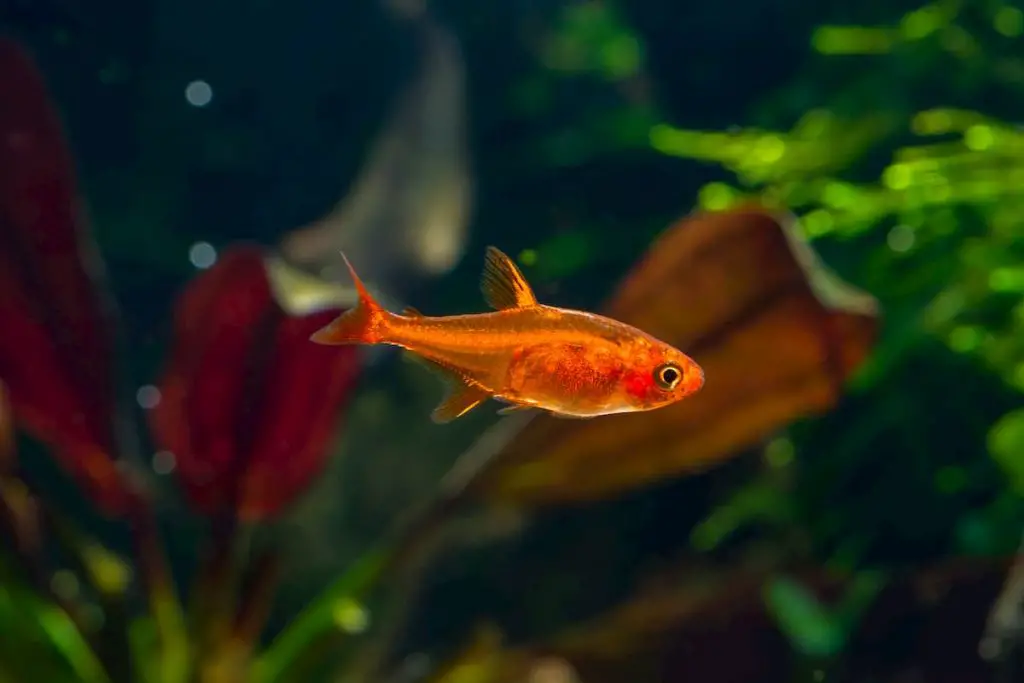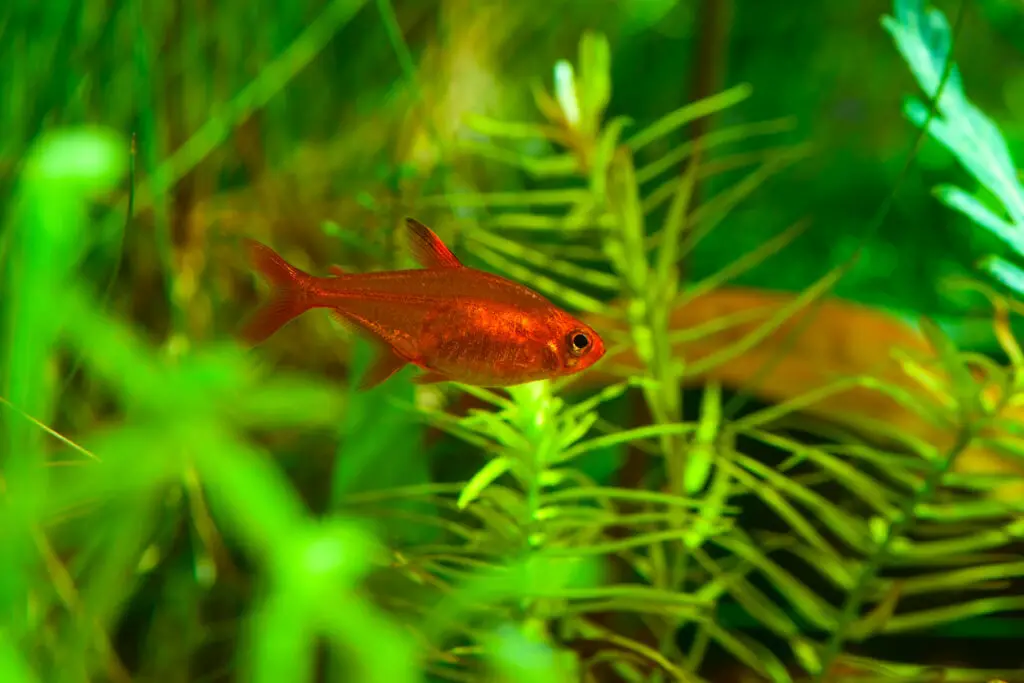If you love colorful, energetic, fun little fish, then you’ll love the ember tetra. These popular fish are small and bright and add a real flame of life to your hobby while working well with a ton of other small fish species.
They’re pretty easy to take care of and love a planted tank.
Let’s dive in for the full care guide for your aquarist needs in caring for the ember tetra.
Quick Intro to Ember Tetra
| Family: | Characidae |
| Scientific Name: | Hyphessobrycon amandae |
| Other Names: | N/A |
| Care Level: | Easy |
Natural Habitat, Identification, and Where to Buy Ember tetra

Ember Tetra, also called Fire Tetra, are a small freshwater fish. This species is part of the Characidae family and can be found in the slow-flowing rivers of the Araguaia river basin region in central-west Brazil.
They are part of a diverse fish order called Characiformes. This order has over 2000 types of fish spread over 19 separate families.
This is a recently described species and was first seen in Mato Grosso, in central Brazil.
This is a popular fish among fish keepers because of its bright appearance.
This species can be easily seen due to having bright and fiery colors. While this fish is active and moving around, it is also not overly aggressive or very demanding in terms of upkeep.
The Ember Tetra’s mellow attitude and ease make this a fish that is great for fish keepers of any experience level. With proper care and a well-maintained tank, this fish can live upwards of two to four years.
This species of fish originates from areas that have heavy vegetation. Their forested homes offer an overabundance of plant life that plays a role in how this fish behaves.
In the wild, they will use logs, driftwood, and water plants as places to hide and for breeding grounds.
This active fish appreciates having plenty of foliage and wood placed in its habitat. This is a playful fish that will happily swim in and around obstacles in their tank.
They prefer to stay in the middle of the tank and will only on occasion swim near the bottom.
Despite their personalities, these fish can take time to adapt to a new tank. During this time, they will be timid and act cautiously.
In nature, this is a shoaling fish and is happiest when kept in a group. To maximize your fish’s happiness and reduce its stress it is best to not buy individuals but to purchase several.
Top tip: Having a group means it will take less time for them to adapt to new environments.
Optimal Water Conditions for Ember Tetra
| Water Temperature: | 68–82°F |
| Water Flow Rate: | Slow flowing water |
| pH: | 5.5-7 |
| Water Hardness: | 18dH |
Tank Setup for ember tetra
| Minimum Tank Size: | 2-3 gallons per fish |
| Optimal Tank Size: | 10 gallons |
| Optimal Tank Shape: | Standard rectangular shaped tank |
| Recommended Filter Type: | Sponge Filter |
In the wild, Ember Tetras make their home in slow-flowing rivers, lakes, and swamps. The areas around the water are filled with plants and trees, many of which are on the riverbed itself.
All of this plant life acts as a natural shelter for the fish when they need to hide from predators or when they are ready to breed.
The region the Ember Tetra from has riverbed soil that is dark and soft, often mixed with either gravel or light rocks.
Author note: When you start to build a tank for this fish it’s important to remember that these slow-moving waters can support a lot of plant life which this fish species loves to swim around in.
For recreating their natural habitat, it is important to pick plants that offer shelter. Plants that can serve in this function include Java Fern, Java Moss, and Anacharis.
To add variety you can always add drifting or free-floating plants like hornwort.
Top tip: While arranging plants, it is important to make sure there is enough room for the fish to swim around in an open space and enough room under the plants to hide.
Each Ember Tetra needs around 1 to 1.2 gallons per fish and fish keepers suggest purchasing this species as a group. A ten-gallon tank can comfortably support a group of eight Ember Tetras.
For the tank itself, it is important to keep the water around 68-82°F. The water hardness should not be greater than 18dH. The pH range should be kept between 5.5 and 7.
Ember Tetras stick to slower moving waters and so your tank needs to reflect this. When possible, using silent filtration is preferred to louder options. One option to keep the water movement down is to use a sponge filter.
This species of fish doesn’t require a special type of substrate; however, darker colored substrates tend to contrast nicely with their vibrant color.
Creating the Landscape for ember tetra

For your Ember Tetras to be happy, they need plants to help them feel safe. Picking the right plants will make your tank look good, help your fish feel better and, the plans can provide oxygenation and help process harmful nitrates.
In nature, Ember Tetras are used to be surrounded by heavy vegetation, so it’s important to have plenty of plant life in your tank. However, make sure there is still plenty of room for your fish to be able to swim around freely.
The plants need to offer a place for the fish to go when they are scared, not the place they will live all their time.
Top tip: There are many plants to choose from, but some of the best choices can include Hornwort, Anacharis, and, Java Moss.
| Best Plants: | Java Fern, Java Moss, Anacharis |
| Best Lighting: | Subdued lighting is best |
| Best Decorations: | Driftwood, plants, aquatic soil |
| Decorations to Avoid: | Over cluttering the tank with plants |
Physiological Considerations for Ember Tetra
| Size: | 0.6–0.8 inch |
| Lifespan: | up to 2 years |
| Temperament: | Peaceful |
| Preferred Tank Region: | Middle to bottom of the tank |
| Scale Thickness: | No special considerations required. |
| Gill Considerations: | No special considerations required. |
| Swimbladder Considerations: | Ember tetras are prone to swimbladder conditions as are most freshwater fish. Avoid overfeeding and dirty fish tanks to help them avoid this ailment. |
| Fin Shape Considerations: | They don’t do well with fin nipping species or sharp or jagged decorations. Avoid these to keep your ember tetras happy and healthy. |
Ember Tetras is a quick-moving and peaceful fish that ranges in length from 0.6 to 0.8 inches. This fish is found in nature in fresh water and is quite sensitive to changes in light, water temperature, and water acidity.
They are healthy fish species and are not prone to any specific diseases.
This species has a merged anal fin, a small dorsal fin, and a large caudal fin. Their dorsal and caudal fins have either a light grey or black gradient. Their heads have a reddish color above the eyes and around the mouth.
Ember Tetras have a compressed back which allows them to be able to move around smoothly and dart around in the water.
They have scales that are compact and are close together which gives them a transparent look. Their shape is slightly elongated with the females’ abdomens being slightly larger than the males.
The female of the species has an air bladder that is larger than the males.
This fish stands out because it has a color that ranges from fiery red to a saturated orange gradient. Normally their eyes will have an orange rim.
Overfeeding can always be an issue with small fish. If they are fed too much food their digestive system can easily be upset. If your fish seems to be acting strange or looks exhausted, their food could be the cause. Quality of food can affect your fish’s health so it doesn’t hurt to invest in high-quality food.
All fish need consistent water renewal to stay healthy. Having fresh water helps with filtration and provide consistent aeration.
Author note: An added complication for the Ember Tetra’s tank is that having a lot of plants requires constant attention. If you do not stay on top of the water quality then it is easy for algae and bacteria to quickly multiply.
Society for ember tetra

Ember Tetras are peaceful fish that enjoy being around other fish species. This little fish does well among others of its kind and it is suggested that you purchase them in groups of eight.
By having a group of their fellow Ember Tetras around, they will have less anxiety, less stress, and adapt to the tank quicker.
Another advantage of buying a group of Ember Tetras is that they are shoaling fish, this means they like to stick together as a group, or are schooling fish. They make for a very impressive visual as they zoom around the tank with their fiery colors.
For those wanting to mix Ember Tetras with other fish species in one tank, this is possible. They perform well in community tanks with other species of fish.
However, it is important to make sure you pick other fish of a similar size and temperament to avoid any fighting.
Ember Tetras like to stay in the middle area of the tank and will not go down to the bottom to eat food. Pygmy Catfish make for a good tank mate choice because this species will eat the food that Ember Tetras doesn’t.
There are several fish that swim in different water layers and make great tank mates. Some of these fish include neon tetras, micro rasboras, dwarf cichlids, rasboras, and hatchet fish.
Other fish that make for good tank mates are fish that have a similar size and temperament. Small Corydoras or other peaceful fish from the Characidae family can be a great fit.
You should avoid housing Ember Tetra with any fish or non-fish that are larger, aggressive, and predatory.
Snails and shrimps can work as good tank mates as long as you make sure to choose species that will not attack the plants that you have in your tank.
Good tankmates for your Ember Tetras
- Other Ember Tetras
- Neon Tetras
- Other varieties of Tetras
- Cory Catfish
- Pygmy Catfishes
- Rasboras
- Hatchetfish
- Shrimp
- Gouramis
Gender, Breeding, and Reproductive Considerations of ember tetra
For those interested in breeding their Ember Tetras you need to have mature males and females. Ember Tetras are free spawning fish which means that the parents do not take care of the produced fry.
This process happens anywhere at four to six months of age. Telling the difference between the genders with Ember Tetra can be quite difficult for those without experience.
The female of the species has a significant rounder shape after having reached maturity. Males are easy to spot during breeding season because their color will turn brighter and help them stand out.
Another typical male trait is that they will show dominant behavior such as chasing after a female to start the courting process.
Once you have identified and properly gendered your fish, the task of breeding them is not very difficult. If you make sure to keep a close watch on the conditions of the tank then spawning can occur often.
The tank in which the mating occurs needs to have dim lights. Make sure the water being filtered is at a weak current so that it will not disrupt the process.
The water pH level should be set to neutral and a water temperature level around 80-82°F
It is suggested that you give the breeding fish (such as Jack Dempsey) live food for around two weeks before they spawn.
After the spawning takes place, the fry needs to be removed from the tank their parents are in and placed in a separate tank.
The produced fry will need a separate tank. You should make sure that this smaller tank has water taken from their future home tank. This similar water will help the growing fry with acclimating when they move.
Nutritional Needs of ember tetra
In the wild, Ember Tetras are hardy fish that has a diverse diet. Their normal diet features a lot of zooplankton and small invertebrates. Other things they eat in nature include both microbe colonies and aquatic plants.
Your captive Ember Tetra will be happy to eat all of that plus more conventional food. They are known to happily eat flakes, granules, and other dry foods.
Experts suggest that if you use artificial food to make sure that you include some frozen or live foods like Aartemia, Daphnia, or Grindal worms.
Other live foods you can consider feeding to your Ember Tetra are bloodworms, insect larvae, and brine shrimp. The more live food you give them, the better they will look.
One easy way for your fish to have a source of snack food is to place plants in your aquarium. Certain plants will attract the Ember Tetra and the fish will graze on these in between meals.
You should pay attention to what you are feeding your fish, diet is key to long term health. Part of a healthy diet involves making sure it is a diverse diet.
If your fish are healthy then they will not need to be given any additional supplements to help their health What an Ember Tetra eats will affect its mood, health, appearance, and even how vibrant its colors are.
So make sure you are being proactive instead of reactive to your fish’s health and diet.
Ember Tetra should be fed in small portions between two and three times a day. When you are preparing to feed them, keep in mind their small size and that some food may need grinding up.
There is a danger to watch out for. It can be easy to overfeed fish and a fish that has been overfed for a long period will become sick and can develop a fatal illness.
To avoid overfeeding your Ember Tetras, it is important to see how much they will eat within two to three minutes of feeding. Try to only add enough food that none will be leftover.
If there is any leftover food from feeding it needs to be cleaned up. Leftover food can begin to rot and add harmful chemicals to the tank.
| Best Sustenance Food Type: | Flakes, Pellets, Freeze Dried Food |
| Additional Food For Optimal Health: | Aartemia worms, Daphnia worms, Grindal worms |
| Special Foods and Considerations for Best Color and Growth: | Bloodworms, insect larvae, brine shrimp |
| When and How Often to Feed Fish Based on Life Cycle: | 2-3 small meals daily, on your schedule |
Common Diseases and How to Avoid and Treat Them

Ember Tetras is a fish that is known for being quite hardy and with the proper care and right tank setup can comfortably live between two to four years.
That said, some diseases can affect your Ember Tetra and it is important to be informed so you can help your fish.
Ich, also called white spot disease, is a common fish illness that causes white spots. This causes the fish to itch and can be treated with medication. It can easily be prevented by doing regular tank maintenance.
Another common illness for Ember Tetras is fungal and bacterial infections. Almost all of these infections are caused by negligence. If this goes untreated it will kill your fish.
This is notable because it causes fins to rot and cloudy masses that are on the fish. This can easily be treated by store-bought antibiotics.
Impaction is an illness that is a blockage of the fish’s digestive tract. This can come about by the fish being fed too much processed dry food and not enough variety.
Since this fish is a voracious eater, if they consume too much dry food it will expand in their stomach and make them sick. This is avoided by giving your fish enough fiber in their diet or letting the dry food soaked in water.
| Best Antibiotics: | Evamisole, Metronidazole, Praziquantel |
| Treatments to Avoid: | None of note. |
| Food Recommendations When Sick: | Try to feed fresh or frozen food instead of pellets and freeze dried foods. |
| Hospital Tank or Isolation Withing the Community Tank: | If your fish has a bacterial or fungal infection it is important to isolate them before they spread it to other fish in your tank. |
7 Facts About Ember Tetras
- The ember tetra is a freshwater fish that is also tropical, they are native to central Brazil.
- This is a smaller fish where the full-grown adult will reach up to 0.8 inches long.
- This fish species was first discovered by Heiko Bleher who named it Hyphessobrycon amandae after his mom, Amanda Bleher.
- Ember Tetra belongs to a diverse fish species called Characiformes.
- This fish has recently become very popular due to its fiery colors.
- Embers are peaceful fish that swims in schools.
- This even-tempered fish is great for those with little to no fishkeeping experience.
FAQs on Ember Tetra

What are the natural settings ember tetras live in?
Ember tetras come from South America. They originate from river basins where water temperature typically ranges from 70 to 82 degrees Fahrenheit.
These rivers are filled with a ton of a muddy substrate with many decayed plants mixed in.
This fish depends on a large number of plants in their environment to help them have a place to swim to when they are stressed or afraid.
They wake up either right before sunrise or just after sunset. During their time awake, they will spend it in the middle levels of the water they live in.
What kind of personality do ember tetras have?
Ember Tetras is a fish known for shoaling. This means that they don’t always swim in the same direction when they are swimming around with other fish.
They are known to be very social fish; even though they are small, they are not known to act timid around fishes bigger than they are under normal circumstances.
Unless the water is bright, they will swim out in the open. They prefer dim lighting and swimming around out in the open if they feel safe.
When they feel safe, they will swim around and play, especially with any other tetras in your tank.
They mimic each other’s actions while swimming around and when they are dashing through plants and around driftwood.
This fish species is not known for fin nipping. However, they may nip at a fish that has trailing fins.
So make sure that you keep any long-finned fish far away from your aquarium housing embers.
